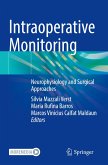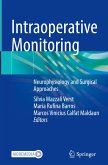Evidence for Neurosurgery
Effective Procedures and Treatment
Herausgegeben:Bartels, Ronald H. M. A.; Rovers, Maroeska M.; Westert, Gert P.
Evidence for Neurosurgery
Effective Procedures and Treatment
Herausgegeben:Bartels, Ronald H. M. A.; Rovers, Maroeska M.; Westert, Gert P.
- Broschiertes Buch
- Merkliste
- Auf die Merkliste
- Bewerten Bewerten
- Teilen
- Produkt teilen
- Produkterinnerung
- Produkterinnerung
This book covers spinal, cranial and peripheral nerve surgeries. Each chapter has a uniform format for ease of reading, including a description of the problem, a literature summary and analysis, and conclusions made using evidence-based medicine (including the GRADE method).
The scientific evidence for a selection of neurosurgical procedures for well-known pathologic entities is thoroughly summarized and analysed in order to provide an overview of the efficacy and effectiveness of procedures in relation to the target patient population.
Evidence for Neurosurgery: Effective Procedures &…mehr
Andere Kunden interessierten sich auch für
![Evidence for Neurosurgery Evidence for Neurosurgery]() Evidence for Neurosurgery97,99 €
Evidence for Neurosurgery97,99 €![Neurosurgery Neurosurgery]() Christos M. ToliasNeurosurgery67,99 €
Christos M. ToliasNeurosurgery67,99 €![Neurosurgery Neurosurgery]() Christos M. ToliasNeurosurgery64,99 €
Christos M. ToliasNeurosurgery64,99 €![Quality Improvement and Patient Safety in Orthopaedic Surgery Quality Improvement and Patient Safety in Orthopaedic Surgery]() Quality Improvement and Patient Safety in Orthopaedic Surgery38,99 €
Quality Improvement and Patient Safety in Orthopaedic Surgery38,99 €![Intraoperative Monitoring Intraoperative Monitoring]() Intraoperative Monitoring86,99 €
Intraoperative Monitoring86,99 €![The Future of Orthopaedic Sports Medicine The Future of Orthopaedic Sports Medicine]() The Future of Orthopaedic Sports Medicine38,99 €
The Future of Orthopaedic Sports Medicine38,99 €![Intraoperative Monitoring Intraoperative Monitoring]() Intraoperative Monitoring171,19 €
Intraoperative Monitoring171,19 €-
-
-
This book covers spinal, cranial and peripheral nerve surgeries. Each chapter has a uniform format for ease of reading, including a description of the problem, a literature summary and analysis, and conclusions made using evidence-based medicine (including the GRADE method).
The scientific evidence for a selection of neurosurgical procedures for well-known pathologic entities is thoroughly summarized and analysed in order to provide an overview of the efficacy and effectiveness of procedures in relation to the target patient population.
Evidence for Neurosurgery: Effective Procedures & Treatment is aimed at a professional audience of junior and consultant neurosurgeons, researchers in the area, and policy makers.
The scientific evidence for a selection of neurosurgical procedures for well-known pathologic entities is thoroughly summarized and analysed in order to provide an overview of the efficacy and effectiveness of procedures in relation to the target patient population.
Evidence for Neurosurgery: Effective Procedures & Treatment is aimed at a professional audience of junior and consultant neurosurgeons, researchers in the area, and policy makers.
Produktdetails
- Produktdetails
- Verlag: Springer / Springer International Publishing / Springer, Berlin
- Artikelnr. des Verlages: 978-3-030-16325-9
- 1st edition 2019
- Seitenzahl: 380
- Erscheinungstermin: 2. September 2020
- Englisch
- Abmessung: 235mm x 155mm x 20mm
- Gewicht: 655g
- ISBN-13: 9783030163259
- ISBN-10: 3030163253
- Artikelnr.: 59936259
- Herstellerkennzeichnung Die Herstellerinformationen sind derzeit nicht verfügbar.
- Verlag: Springer / Springer International Publishing / Springer, Berlin
- Artikelnr. des Verlages: 978-3-030-16325-9
- 1st edition 2019
- Seitenzahl: 380
- Erscheinungstermin: 2. September 2020
- Englisch
- Abmessung: 235mm x 155mm x 20mm
- Gewicht: 655g
- ISBN-13: 9783030163259
- ISBN-10: 3030163253
- Artikelnr.: 59936259
- Herstellerkennzeichnung Die Herstellerinformationen sind derzeit nicht verfügbar.
Ronald Bartels was born in 1962 in Maastricht, the Netherlands. He gained his medical degree from Catholic University Nijmegen, which is now Radboud University Nijmegen. In 1996 he gained his Board certification in neurosurgery, and his certification in spinal surgery in 1999. He obtained his Certification epidemiologist B (SMBWO) in 2008. He is currently Full Clinical Professor and Chair of the department of Neurosurgery, Radboud University Medical Center, The Netherlands. Maroeska M. Rovers was born in Doetinchem, the Netherlands in 1973. She completed her MSc in Biomedical Health Sciences in 1996, and her PhD on 'Otitis media with effusion in infants: the effects of ventilation tubes' in 2000. She is currently Professor of Evidence-Based Surgery at Radboud University Medical Centre, Nijmegen, the Netherlands. Furthermore, she is a member of the council of the IDEAL collaboration, a group of leading surgeons and methodologist whom aim to improve the quality of research in surgery. Gert P. Westert was born in Ommen in 1961. He completed his MSc in medical sociology and reserach methodology in 1978 and his PhD on 'Variation in Use of Hospital Care' in 1991. He is director of IQ healthcare and full professor Quality of Health Care and Health Services Research at Radboud University Medical Centre, Nijmegen, The Netherlands. IQ healthcare is a scientific centre for research, education and support of quality, safety and innovation in healthcare and one of the leading scientific institutes in this field in Europe. He has 25 years of experience as a health services researcher and published 250 papers in various journals.
Chapter 1. Evidence in Neurosurgery.- Chapter 2. The value of decompressive craniectomy in Traumatic Brain Injury.- Chapter 3. Cranioplasty: Does timing have any effect on the degree of neurological recovery or the complication rate?.- Chapter 4. Age: a criterion to offer surgical treatment as a cytoreductive tool for malignant primary brain tumour?.- Chapter 5. A restriction for the surgical or endovascular treatment of a ruptured aneurysm in the elderly.- Chapter 6. Subarachnoid hemorrhage due to ruptured intracranial aneurysm: Clipping or coiling.- Chapter 7. Subarachnoid hemorrhage due to ruptured intracranial aneurysms: the scientific base for flow diverters.- Chapter 8. Controversies in deep brain stimulation surgery: micro-electrode recordings.- Chapter 9. Chiari Malformation: Posterior Fossa Decompression With or Without Duraplasty?.- Chapter 10. Craniosynostosis: endoscopically versus open treatment.- Chapter 11. Posterior Decompression for Cervical Spondylotic Myelopathy: laminectomy, laminectomy and fusion or laminoplasty.- Chapter 12. Early Versus Delayed Surgery for Cervical Disc Herniation.- Chapter 13. The oblique corpectomy, forgotten but an effective procedure? A systematic review.- Chapter 14. Cervical arthroplasty: the evidence.- Chapter 15. Cauda Equina Syndrome due to ruptured lumbar intervertebral disc: optimal timing for surgery.- Chapter 16. The use of minimal invasive techniques for lumbar herniated disc in comparison to more classical approaches.- Chapter 17. Comparative Analysis of Open Versus Minimally Invasive Techniques for Posterior or Transforaminal Lumbar Interbody Fusion.- Chapter 18. Preoperative preparation of osteoporotic patients for instrumented spine surgery.- Chapter 19. Cubital Tunnel Syndrome - Primary decompression or transposition of the ulnar nerve at the elbow.- Chapter 20. Open versus endoscopische cubital tunnel release.- Chapter 21. Surgical Treatment of Meralgia Paresthetica.
Chapter 1. Evidence in Neurosurgery.- Chapter 2. The value of decompressive craniectomy in Traumatic Brain Injury.- Chapter 3. Cranioplasty: Does timing have any effect on the degree of neurological recovery or the complication rate?.- Chapter 4. Age: a criterion to offer surgical treatment as a cytoreductive tool for malignant primary brain tumour?.- Chapter 5. A restriction for the surgical or endovascular treatment of a ruptured aneurysm in the elderly.- Chapter 6. Subarachnoid hemorrhage due to ruptured intracranial aneurysm: Clipping or coiling.- Chapter 7. Subarachnoid hemorrhage due to ruptured intracranial aneurysms: the scientific base for flow diverters.- Chapter 8. Controversies in deep brain stimulation surgery: micro-electrode recordings.- Chapter 9. Chiari Malformation: Posterior Fossa Decompression With or Without Duraplasty?.- Chapter 10. Craniosynostosis: endoscopically versus open treatment.- Chapter 11. Posterior Decompression for Cervical Spondylotic Myelopathy: laminectomy, laminectomy and fusion or laminoplasty.- Chapter 12. Early Versus Delayed Surgery for Cervical Disc Herniation.- Chapter 13. The oblique corpectomy, forgotten but an effective procedure? A systematic review.- Chapter 14. Cervical arthroplasty: the evidence.- Chapter 15. Cauda Equina Syndrome due to ruptured lumbar intervertebral disc: optimal timing for surgery.- Chapter 16. The use of minimal invasive techniques for lumbar herniated disc in comparison to more classical approaches.- Chapter 17. Comparative Analysis of Open Versus Minimally Invasive Techniques for Posterior or Transforaminal Lumbar Interbody Fusion.- Chapter 18. Preoperative preparation of osteoporotic patients for instrumented spine surgery.- Chapter 19. Cubital Tunnel Syndrome - Primary decompression or transposition of the ulnar nerve at the elbow.- Chapter 20. Open versus endoscopische cubital tunnel release.- Chapter 21. Surgical Treatment of Meralgia Paresthetica.








